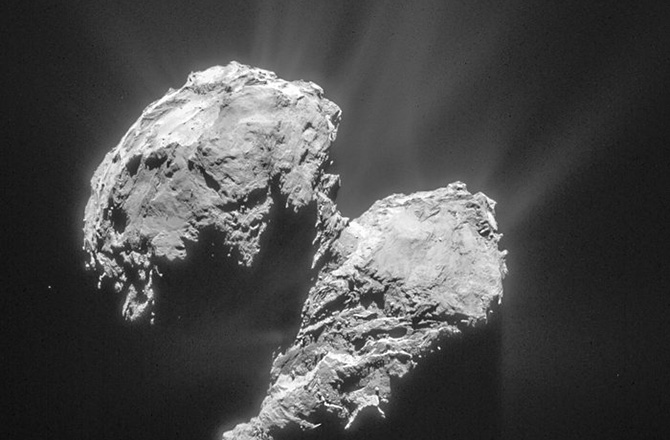Rosetta Spacecraft Gets Confused by Rough Comet 'Weather'

As the European Rosetta spacecraft continues to explore Comet 67P/Churyumov-Gerasimenko as it gradually gets closer to the sun, it's having to deal with some very inclement orbital weather, triggering some confusion in the spacecraft's automated navigation systems.
As 67P's surface receives more sunlight, Rosetta is seeing an uptick in gas and dust blasting into space from the comet's icy nucleus. While the observations may look serine from afar, as the comet chaser dives in for close passes of the cometary surface, the environment surrounding 67P is anything but.
7 Intimate Close Encounters with Comets
Inevitably, as more gas and dust is ejected from the comet, driven by sublimating ices being heated by sunlight, the orbital environment has become denser. This has had the predictable effect of causing drag on Rosetta's large solar array. But during a daring close pass of 67P on Saturday, a cascade of problems eventually forced the mission into safe mode while mission scientists scrambled to find a fix. [Photos of Rosetta's Comet Mission]
During a previous close approach of the comet on Feb. 14, an unexpected problem arose when one of the spacecraft's navigation systems became confused by the debris being kicked into space. Rosetta's star tracker watches known stars and constellations to autonomously ensure its high-gain antenna is constantly pointing at Earth — much like mariners through history have used the stars to navigate the oceans.
But an increase in debris in the star tracker's field of view can cause it to mistaken the bright chunks of comet as stars, triggering the spacecraft to point away from Earth. This has inevitably impacted communications with Rosetta.
NEWS: Rosetta's Comet May be Made of Pebbles
Get the Space.com Newsletter
Breaking space news, the latest updates on rocket launches, skywatching events and more!
During Saturday's flyby — which took Rosetta only 6 kilomters (3.7 miles) from the surface — the star tracker issue resurfaced again, throwing the spacecraft off-kilter.
Attempts were made to regain tracking capabilities, but there was too much background noise due to activity close to the comet nucleus: hundreds of 'false stars' were registered and it took almost 24 hours before tracking was properly re-established," writes a Rosetta blog update.
Throughout these tracking difficulties, mission control were aware that the navigation errors were mounting, pushing Rosetta further and further off-point. The strength of the radio signal was dropping, indicating that the spacecraft was repeatedly confusing debris for background stars.
Fortunately, the system finally automatically corrected itself and ESA engineers saw the radio signal come back to full strength, signifying that Rosetta's attitude had snapped back to the correct direction.
But the star tracker was still confused, intermittently causing glitches in its pointing so mission control attempted to reconfigure the onboard systems to iron out these inconsistencies in navigation — this triggered a safe mode.
ANALYSIS: Rosetta's Comet Fires its Jets
Safe modes are built into spacecraft systems to prevent a small error or glitch cascading into a larger, potentially mission-threatening situation. As Rosetta switched to safe mode, all science instruments were powered down and only the most essential systems were up and running.
Through Sunday and Monday, mission scientists were able to work through the safe mode and bring the spacecraft back to normal operations, sending it on a trajectory that will take it 200 kilometers (125 miles) from the nucleus and far away from the debris causing all these navigation hassles.
But another close pass of 67P is planned and there are concerns for Rosetta's safety, especially as we are likely to see an increase in cometary activity (and therefore even more debris) as Comet 67P/Churyumov-Gerasimenko approaches perihelion (point of closest approach in its orbit around the sun) in August.
These recent troubles highlight how rough is can be to investigate a comet at such close quarters and these lessons will no doubt impact mission planning — particularly whether or not, during Rosetta's next close approach, the spacecraft should again venture so close. But it also demonstrates what an amazing scientific boon Rosetta is to our understanding of comet dynamics as these ancient lumps of icy material plow through the inner solar system.
For more information about Rosetta's recent adventures and high-resolutuion imagery, follow updates on the ESA Rosetta Blog.
This article was provided by Discovery News.
Join our Space Forums to keep talking space on the latest missions, night sky and more! And if you have a news tip, correction or comment, let us know at: community@space.com.
Ian O'Neill is a media relations specialist at NASA's Jet Propulsion Laboratory (JPL) in Southern California. Prior to joining JPL, he served as editor for the Astronomical Society of the Pacific‘s Mercury magazine and Mercury Online and contributed articles to a number of other publications, including Space.com, Space.com, Live Science, HISTORY.com, Scientific American. Ian holds a Ph.D in solar physics and a master's degree in planetary and space physics.









